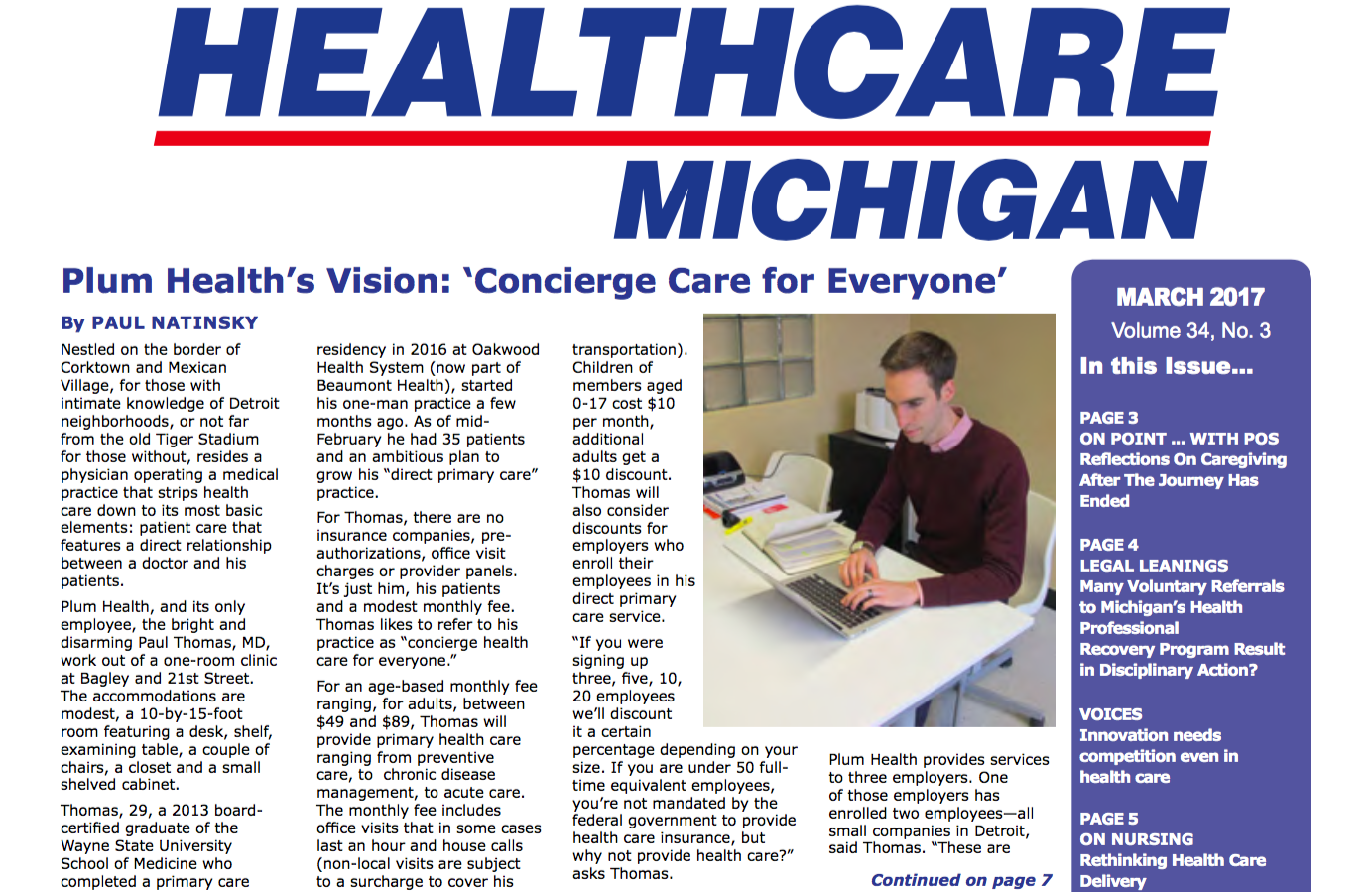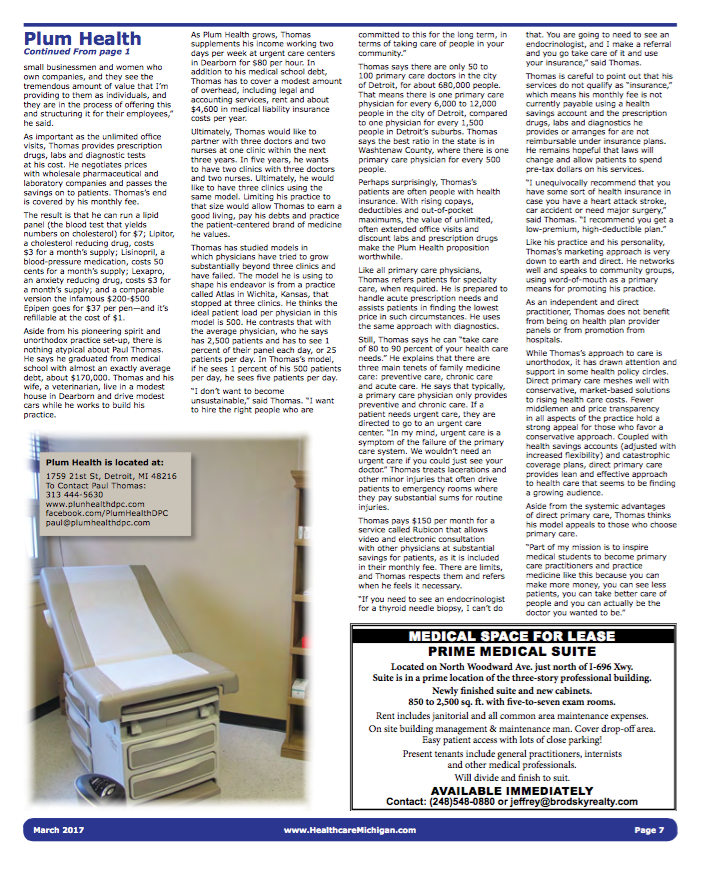Plum Health Blog
Common Criticisms of Direct Primary Care
In this blog post, I'm going to list some common criticisms to Direct Primary Care and my responses to these criticisms.
In a traditional family medicine practice, each doctor typically sees a panel of 2,500 patients. If each patient comes in twice each year, that means roughly 100 visits each week, assuming that the doctor works 50 weeks each year, or roughly 20 visits each day. In Direct Primary Care, doctors reduce their clinic panel to 500 patients. Now, if each patient visits twice each year, the doctor will see 20 patients each week, or 4 patients each day. If each patient visits three times each ear, the doctor will see 30 patients each week, or 6 patients each day. This allows the doctor to spend up to an hour with each patient and use the remaining time in their schedule to answer phone calls, texts, and emails as well as handle the administrative duties that go along with running a Direct Primary Care practice.
The biggest criticism of doctors who switch from a traditional or fee-for-service practice to Direct Primary Care is this notion of patient abandonment. This means that if the doctor cuts down their practice from 2,500 patients to 500 patients, there will be 2,000 patients that are "abandoned" or without primary care services.
My response to this is simple: I will no longer perpetuate a bad system. In the current fee-for-service system, patients do not have enough time with their doctor for a thorough evaluation, for all of their questions to be answered, and to feel truly cared for. In the current fee-for-service system, doctors are rushing from room to room to room and are unable to provide the kind of high-quality care that their patients deserve,
In the current system, primary care doctors are marginalized and devalued, predisposed to burn out and leaning towards early retirement. Younger medical students see their burnt-out, grumbling, and overstretched attending doctors in Family Medicine and choose not to become primary care doctors in the first place. Why earn less than other specialties in a field that is less-than fulfilling?
Direct Primary Care doctors are fighting to make primary care relevant again, to restore the doctor-patient relationship, and to create value for patients in a way that the current fee-for-service system cannot.
There's an old adage: "take care of yourself so you can care for others", and it's something that primary care doctors have forgotten about. The expectation of the system is that we should work hard, keep our heads down, and not question the health care administrators who send an overwhelming volume of patients into our clinics each day.
But when we begin to sacrifice the quality of our work simply because we don't have enough time, it's time to take a stand and re-think our practices.
This brings me to the next criticism: how many conditions can a primary care doctor really treat? aka how much coverage can a family medicine doctor really provide?
When a well-trained family medicine doctor is able to practice at the top of their training, they are able to manage between 80 and 90% of all patient concerns. From sore throats, to blood pressure management, Pap tests, skin biopsies, abscess drainage, diabetic management, and beyond, family medicine doctors are able to care for a broad and diverse range of conditions.
The secret sauce in Direct Primary Care is the amount of time we are able to spend with our patients. If I have an hour, I can use it to drain an abscess, to talk about the efficacy of your antidepressants, to draw your blood for the lab work you need, to remove that ingrown toenail, to fully evaluate your vertigo, to evaluate your child's Vanderbilt scores for ADHD, to dispense the necessary medications and more.
In the current fee-for-service system, the expectation is that primary care doctors perform a cursory evaluation and then make a referral to a specialist. In the Direct Primary Care model, primary care doctors have more time to address concerns to the fullest of their training. And if that specialty referral is necessary, Direct Primary Care doctors have enough time to personally manage the transition of care, to make the follow up phone call and to get a full picture of what happened during that referral.
To summarize, Direct Primary Care doctors who leave the traditional fee-for-service system are not abandoning their patients. Rather, they are now free to practice medicine to the best of their ability by having enough time to give high-quality, thoughtful, and comprehensive primary care services to their patients. This will allow burnt out doctors to stay in practice for a longer period of time and it may inspire the next generation of medical students to choose primary care.
Thanks for reading, and have a wonderful day,
- Dr. Paul Thomas with Plum Health Direct Primary Care
Plum Health DPC Featured in The HUB Detroit
This week, we were featured in an article by The HUB Detroit, a local publication that focuses on Detroit neighborhoods. From their mission statement, they emphatically state: "our focus is Detroit’s neighborhoods. TheHUB’s multimedia platforms were created to give Detroit city residents and supporters a dedicated voice and space to discuss the real issues surrounding viable city neighborhoods."
I am happy to be working in the neighborhoods in the City of Detroit, serving folks of diverse backgrounds via my clinic in Southwest Detroit. The article touched on this point by relating that I am embracing the neighborhood where I practice medicine. It's true - I spend a lot of time reaching out to folks in the community like small business organizations, small business owners, and non-profit groups like the Ford Resource and Engagement Center.
Our goal is to improve the health and wellness of not only individuals, but also the community and we achieve this by delivering affordable, accessible healthcare in our community.
I really appreciate the time that the editorial staff took to share the Plum Health story, and I'm excited for what the future holds for health in our City and our region.
Thanks for reading, and have a wonderful day,
- Dr. Paul with Plum Health
What is Family Medicine?
Hello, this is Dr. Paul Thomas with Plum Health DPC and I'm a Family Medicine Doctor in Detroit. I operate Plum Health Direct Primary Care, which delivers affordable, accessible health care services in Detroit.
This week, I'm talking about Family Medicine Week, an official announcement from Governor Rick Snyder that makes February 19th - 25th Family Medicine Week. I'm a month late in bringing this up, but it's still important to recognize Family Medicine and the contribution of Family Medicine Doctors across the State of Michigan.
For starters, Family Medicine Doctors compete four years of undergraduate education, four years of medical school, and three years of residency. That's 11 years after high school and 7 years after college. Furthermore, some Family Medicine Doctors sub-specialize within Family Medicine.
They complete a 1 year fellowship to become Sports Medicine doctors, or Family Medicine doctors that sub-specialize in adolescent medicine, geriatric medicine, addiction medicine, etc...
The point is that Family Medicine doctors are highly trained, and specialize in taking care of the whole patient in the context of the family and the community.
Family Medicine doctors care for people of all ages and stages! We help deliver babies, we help infants meet developmental milestones, we complete school, work, and sports physicals, we take care of injuries like fractures and lacerations, and we take care of chronic conditions like diabetes, high blood pressure, and asthma.
Family Medicine doctors also work across a variety locations. Family Medicine doctors work in emergency departments, in-patient hospital settings, and out-patient clinics. Family Medicine doctors lead health departments for Cities, Counties, and States. Family Medicine doctors teach at medical schools, volunteer at homeless clinics, and travel abroad with organizations like Doctors without Borders.
Personally, I love being a Family Medicine Doctor - I love taking care of people regardless of their age, race, gender, and orientation. I love being able to offer care and compassion to those who need it, along with the standard medical care.
Finally, we need more Family Medicine doctors to create healthy communities, healthy cities, and a healthy nation. Family Medicine doctors address small issues before they become big, complicated problems. Family Medicine doctors and Primary Care Physicians can effectively increase the health of a community and lower the cost of care in that community.
Primary Care and Family Medicine is vital, and I'm glad that we have a week to recognize the work that Family Medicine doctors carry out each day in the State of Michigan.
Thanks for your time, and have a wonderful day,
- Dr. Paul Thomas
Plum Health Featured in Healthcare Michigan
On February 9th, I was invited as a panelist at the Future of Healthcare event at Wayne State University School of Medicine. While at the event, I met Paul Natinsky, a writer for Healthcare Michigan. Friendly, outgoing and genuinely interested in the work that I was doing, Mr. Natinsky and I scheduled to meet up a few weeks later.
When Mr. Natinsky came to our Plum Health office, he brought his tape recorder and camera, and most importantly he brought his insight and some tough questions. We talked for well over an hour on a variety of subjects. This week, he released his notes from that meeting in the form of a publication in Healthcare Michigan.
The work that we're doing with Plum Health is the feature story in the March 2017 issue, and we couldn't be happier about spreading the word about Direct Primary Care in Michigan. You can read the article in full, here.
Thanks for reading, and have a wonderful day!
- Dr. Paul








